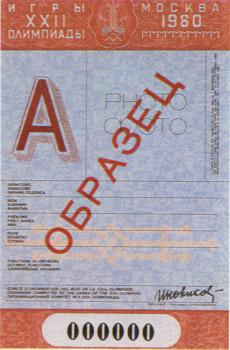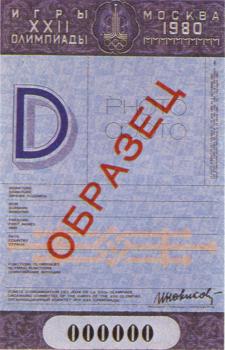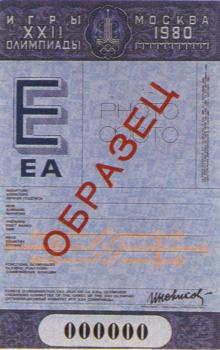Identity Card
All the ID cards and press accreditation cards were issued to persons
named by the International Olympic Committee, National Olympic Committees,
International Federations, international agencies, broadcasting organisations,
newspapers and magazines. They were entitled to certain privileges as provided
for in the Olympic Charter. The cards had alphabetical codes for categories,
were distinctively coloured and contained 
Category A cards were issued to members and honorary members of the IOC, and to the Director of the IOC. Each of them was also given a card for an accompanying guest. Cards A authorised access to all the Olympic facilities, living quarters and the international zone of the Olympic Village, and to seats in Stand A at the competition sites. Category B cards were given to the Presidents and General Secretaries of the NOCs, to the Presidents, General Secretaries, and Technical Delegates of the IFs, and to the Presidents and General Secretaries of the organising committees of the 1976 and 1984 Olympic Games. Each of them was also entitled to one card for an accompanying guest. Cards B were also issued to members of the IOC Commissions and Secretariat and provided access to all the Olympic facilities, including the living quarters and international zone of the Olympic Village, and entitled the holders to seats in Stand B at all the competition sites. Category C cards were provided for chefs-de-mission, their assistants,
and for the Olympic attaches. In addition, the same types of cards were
issued to holders of Olympic diplomas. Each of them was also given one
card for an accompanying guest. The card gave access to seats in Stand
C at all the competition sites.

Cards of D Category were issued to jury members and technical officials (referees, judges, timekeepers, or inspectors) appointed by their respective IFs. The authorised access to competitions in appropriate events with the rights to take seats at D Stand of the sites and of the Grand Arena of the Central Lenin Stadium. Each card had the pictograph of a respective sport. Category F cards were given to team officials and competitors. Holders of such cards lived in the Olympic Village and visited the sites where competitions in their sports were held with the right to seating in F Stand. Each card had the pictograph of a respective sport. Cards of G Category were provided for honorary guests of the OCOG-80. They could visit all the competitions producing complimentary passes and were entitled to seats in Stand G. Category N cards were issued to observers of the organising committees of the future Olympic Games and of regional games. They were allowed to visit competition sites and other Olympic facilities in accordance with the range of problems they studied. Cards of M Category were given to members of the International Youth Camp and permitted access to the sites where events planned by the programme of the Camp were staged. Holders of such cards were admitted to competition sites on producing tickets. Members of the mass media officially accredited at the Games of the
XXII Olympiad were given accreditation cards with E symbol.

In keeping with the bye-law to Rule 49 of the Olympic Charter, members of the written and spoken press as well as their support and auxiliary personnel were provided with accreditation cards of nine varieties. 1. El accreditation cards were issued to the international agencies: 2. EA accreditation cards were issued to national news agencies. 3. EE accreditation cards were distributed to daily newspapers, other periodicals, and to freelance writers. Holders of the El, EA, and EE cards (persons engaged by an agency as reporters, editors or photographers) were entitled to access to all the competition sites (with seating in E Stand), training sites, the Main Press Centre, subcentres, and the OTVRC. 4. EAT accreditation cards were issued to personnel of the news agencies to carry out duties other then mentioned in paragraphs 1-3. They gave access to the Main Press Centre, subcentres, to E sections at venues without seating rights, and to training sites. 5. EP accreditation cards were given to photographers, including those of the agencies and pools. They authorised access to all the competition sites with seating at E Stands or in specially assigned areas, to training sites, the Main Press Centre, subcentres, and the OTVRC. 6. EF accreditation cards were provided for crews for film or television news. They entitled the holders to entry into all the venues with rights to occupy vacant seats in E stands, to training sites, the Main Press Centre, subcentres, and the OTVRC. 7. EC accreditation cards were issued to TV and radio commentators. Using the cards, they were able to visit any venue with seating at commentator positions or taking vacant seats at E press stand, any training site, the Main Press Centre, subcentre, or the OTVRC. 8. ES accreditation cards were designed for auxiliary personnel of radio and television. The cards gave access to all the venues, including access to commentator positions without seating rights, to training sites, the OTVRC, the Main Press Centre, and subcentres. 9. ET accreditation cards were intended for radio and TV support staff. They gave access to all the venues, including free entry to commentator positions without the right to occupy seats, to training sites, the OTVRC, the Main Press Centre, and subcentres. To provide access to the international zone of the Olympic Village, the press and photographers were allotted 300 passes, as specified by the byelaw to Rule 49 of the Olympic Charter. As required by Rule 48 of the Olympic Charter, the IOC, IFs, and NOCs were provided with transferable passes as follows: - 12 passes of Category B for persons named by the IOC with access to all the competition sites and seating in sections B; - 12 passes of C Category for persons chosen by each IF with access to all the competition sites and seating in sections C; - one C pass per every 20 competitors of a national team with access to all the venues and seating in sections C; - 12 D passes for the International Amateur Athletics Federation (IAAF), which authorised access to the Grand Arena of the Central Lenin Stadium and seating in section D. The transferable passes were valid if accompanied by a document identifying the holder. Just as the other ID cards, the transferable passes were issued at the accreditation centres to the IOC Director, Presidents or General Secretaries of IFs, or NOCs who signed each pass before it was laminated, that is sealed into a plastic pouch. Forms of ID cards for categories A, B, C, D, and F consisted of 3 identical parts, measuring 12 by 8 cm each. The card face bore the following particulars: the emblem of the Games of the XXII Olympiad, card number, a letter designating the card category and section of the stands the holder was entitled to, time of validity, space for the photograph, lines for indicating surname and first name (s), country, Olympic function, the holder's signature, and the signature of the President of the OCOG-80. The reverse side carried the card number, a letter designating the card category and section of the stands the holder was entitled to, lines for indicating surname, first name (s), sex, date and place of birth, nationality, home address, occupation, Olympic function, signature of the President or General Secretary (Director) of the IOC, or NOC, or IF, and space for a stamp. The A, B, C, D, and F identity card forms (all their three parts) were filled out in French, English, or Russian. The text was typed in Roman characters. Surname and the first name (s) were spelt exactly as they were spelt in the holder's passport in block letters on the face and reverse sides of the form. A 5x4 cm black-andwhite photograph was affixed on each part. After it had been filled in, the form was signed by its holder and by the officials listed on the form and validated with the stamp of the IOC, NOC, or IF concerned. One part of the form with an enclosed extra photograph, bearing the holder's first name (s), surname and form number on the back, was returned to the OCOG-80, along with a completed checklist. Under the heading "Olympic function", the holder's status, in accordance with his/her Olympic duties, was indicated. For competitors and persons associated with one particular sport, this sport was indicated after identification of the duties. A form of a press accreditation card for E Category of all varieties consisted of two identical parts, each measuring 12x8 cm. The same data were indicated on the face and reverse sides of the form. Forms for cards of honorary guests, members of the International Youth Camp, observers (G, M, and N categories) consisted of two similar parts. Their size and contents were the same as those of cards for the rest of the Olympic family. E press accreditation cards of any type and G, M, or N identity cards were filled out in the same way as the ID card forms of A, B, C, D, and F categories. In case of a typing error, forms for ID cards and accreditation cards
were cancelled and new ones were completed instead. The cancelled or unused
forms were returned to the OCOG-80 together with completed checklists. (Source Document: Official Report 1980, Vol
2, page 473 ff ) |